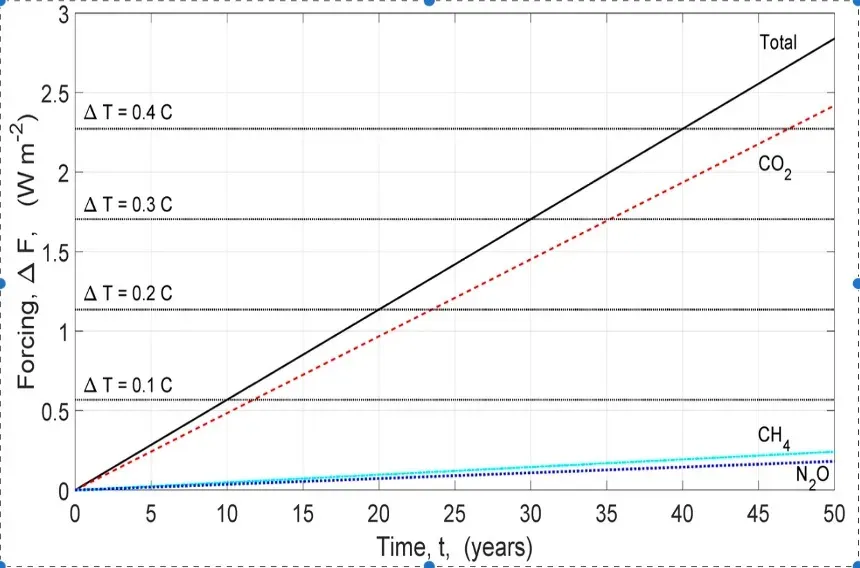Table of Contents
In 2,326 jurisdictions around the world – representing over one billion people – climate emergencies have been declared.
At the World Economic Forum, former US Vice-President Al Gore recently railed about impending “rain bombs” and “boiling oceans” due to global warming. Last year UN Secretary-General Guterres accused leaders of “throwing fuel on the fire. Literally…a future of ferocious storms, floods, droughts, wildfires and unlivable temperatures in vast swathes of the planet.”
And there have been many other similar statements made by world leaders and the media, so should it surprise anyone that groups like Just Stop Oil are active?
Obviously, people are worried, some are hysterical, and this will remain the situation until climate change is better understood.
I do believe, however, Al Gore’s statement that we’re treating our atmosphere – that thin blue line in the photo above – as an “open sewer” to be fair, but not his pronouncements on the impact of greenhouse gases (GHGs).
Governments are pushing for “net-zero” – achieving a balance between greenhouse gas emissions produced and greenhouse gas emissions removed. This implies a ban on burning fossil fuels to “decarbonize” economies. The UN says dramatically that: “Transitioning to a net-zero world is one of the greatest challenges humankind has faced. It calls for nothing less than a complete transformation of how we produce, consume and move about.”
Whatever “complete transformation” means, it will involve immense disruption and hardship, especially for poorer nations.
But do the facts justify a drastic solution to an imperfectly understood problem?
Challenging the consensus
We are told repeatedly that we must follow the science on climate change. It is “settled science”; there is scientific consensus; and there’s nothing substantial to discuss. This is not true. There are many credible scientists who disagree with apocalyptic views of climate change. These outliers are often ignored or cancelled by their colleagues because their views threaten the groupthink of the climate establishment. A huge amount of funding is at stake[1].
Climate scientists W A van Wijngaarden of York University in Canada and William Happer of Princeton University (W&H) are two such gutsy and independent thinkers.
Unlike climate politicians Gore and Guterres, W&H have each spent a lifetime studying physics. They have recently published papers that could alter the trajectory of the climate debate. Among these, one discusses the relative potency of greenhouse gas molecules; the other examines the contribution of nitrous oxide to global warming – a controversial topic, as it is released into the air from fertilizer that is spread by farmers onto their fields (nitrogen cycle, p 31 here).
Let’s contrast the view of the climate establishment with that of W&H and others.
| Climate establishment messaging | van Wijngaarden and Happer (W&H) |
| CO2 is a pollutant | CO2 is not a pollutant and is essential to plant growth. CO2 is a colourless, odourless, tasteless, non-combustible gas and it is not involved in the production of smog. |
| CO2 is a potent GHG | CO2 is a mild GHG. Doubling the concentration of CO2 from today’s 419 ppm level to 838 ppm will increase the absolute temperature by about 0.25% or about 0.8 deg C, assuming that there are no positive or negative feedbacks that would increase or decrease the predicted warming. |
| At 419 parts per million (ppm), the current concentration, there is too much CO2 in the atmosphere and it needs to be reduced. | Plant growth would benefit from higher levels of CO2. “For most greenhouse crops, net photosynthesis increases as CO2 levels increase from 340-1,000 ppm. Most crops show that … increasing the CO2 level to 1,000 ppm will increase the photosynthesis by about 50% over ambient CO2 levels.” |
| CO2 concentration may exceed 1000 ppm by 2100 with no net-zero (pp 53-54 here) | The current CO2 concentration growth rate is about 2.5 ppm/year. At that rate, it would take about 232 years to reach 1000 ppm, AD 2255. |
| CH4 (methane) is a potent GHG and its emission rate needs to be reduced. Its current level is 1924 parts per billion (ppb). | One additional molecule CH4 of the GHG methane raises the temperature about 31 times more than one additional CO2 molecule, but the concentration of CO2 is increasing about 300 times faster than that of CH4. Therefore, CH4 warms the planet at 1/10 the contribution of CO2. No reduction in CH4 emissions is needed. (Table 3, p.21 here) |
| N2O (nitrous oxide) is a potent GHG and its emission rate needs to be reduced. Its current level is 336 ppb. | One additional molecule N2O of the GHG nitrous oxide raises the temperature about 233 times more than one additional CO2 molecule, but the concentration of CO2 is increasing about 3100 times faster than that of [N2O] . Therefore, N2O warms the planet at about 1/13 the contribution of CO2, 0.064 deg C/century. No reduction is needed. (p.1 and Table 3, p.21 here) |
| Sustainable Development Policies will substantially decrease the risk of hunger. (p 143 here) | Elimination or reduction of fertilizer, a source of N2O, will decrease the world food supply, worsen food security and cause widespread starvation. |
| Total anthropogenic radiative forcing (“changes in Earth’s energy balance (‘forcing’)”) could reach almost 10 Wm-2 by 2100 relative to 1850-1900. (p 53 here) | At the current CO2 growth rate of 2.5 ppm, the CO2 concentration in 2100 will be about 612 ppm. This will increase forcing by about 3.6 Wm-2 relative to 1850-1900.[2] |
| “For the decade 2011-2020, the increase in global surface temperature since 1850-1900 is assessed to be 1.09 [0.95 to 1.20] deg C.” (p 41 here.) “Global surface temperatures are more likely than not unprecedented in the past 125,000 years.” (p 61 here). Global surface temperature relative to the period 1850-1900 could reach almost 7 deg C by 2100 with no net-zero. (p 53 here). Global surface air temperature relative to the period 1850-1900 could almost reach 5 deg by 2100 with no net-zero. (p 80 here). | Relative to 1850 the total warming in 2100 will be (1.09 + X + Y) deg C where 1.09 deg C is the total warming from 1850 to 2020, X is the warming due to CO2 from 2020 to 2100, and Y is the warming (or cooling if Y is negative) due to natural causes from 2020 to 2100. X = 0.426 deg C[3] We can’t be sure how natural causes will alter the temperature in the future, but we can infer what it was from 1850 to 2020 and make an estimate. [4] Y = 0.295 deg C. TOTAL estimated warming in 2100 relative to 1850 = 1.09 + 0.426 + 0.295 = 1.81 deg C. This assumes a cloudless sky, no positive or negative feedback and continued emissions of CO2 at the current rate. |
| “…net-cloud feedback is positive (high confidence) … previously the major source of uncertainty in the net cloud feedback, is improved owing to a combined use of climate model simulations, satellite observations, and explicit simulations of clouds, altogether leading to strong evidence that this type of cloud amplifies global warming. The net cloud feedback is assessed to be +0.42 [–0.10 to 0.94] W m–2 deg C–1. A net negative cloud feedback is very unlikely.” (pp 95-96 here) | Clouds have negative feedback and will decrease, not increase total warming. |
| “Establishing links between specific GWLs [global warming levels] with tipping points and irreversible behaviour is challenging due to model uncertainties and lack of observations, but their occurrence cannot be excluded, and their likelihood of occurrence generally increases at greater warming levels (Box TS.1, Section TS.9)” (p 59 here). | The strongest argument against any tipping points of Earth’s climate is the extreme stability it has shown over geological history. Even the onset and end of the ice ages of the last million years or so have been relatively slow, even though they seem to be driven by huge forcings of the Milankovitch cycles. |
| Global climate models are reliable | Global climate models are unreliable[5] because they assume huge positive feedback from water vapour and clouds in contradiction to Le Chatelier’s Principle. |
| Climate change is human induced. | Most of the warming has been due to the natural recovery from the Little Ice Age. For the past 50 years, CO2 may have contributed a few tenths of a degree on top of natural warming. |
| “Response of the climate system relative to 1850-1900” (p 89 here). “From climate risk to climate resilient development…” (Figure TS.2 p 42 here). Observed impacts of climate change: (p 46 here). A warming of 1.5 deg C will worsen the situation and produce moderate to very high risks and impacts (pp 58-59 here). | The IPCC 1.5 deg C target has no real meaning. Warming will be different at different locations of the Earth. Most of the warming will be near the poles, at night and in winter. The average temperature of the Antarctic ice sheet is –27 deg C in summer and –62 deg C in winter, far below the 0 deg C melting point of ice. So, a few degrees of warming, which is all you can credibly expect for doubling or quadrupling CO2 concentrations, would still leave the ice frozen solid. Similarly, Arctic temperatures in winter are well below zero. The historical temperatures for Iqaluit, Nunavut, for example, can be seen here. On balance, the 1.5 deg C warming would be beneficial. |
Surprised? Obviously, both can’t be right.
The total warming from 1850 to 2100 with no net-zero is estimated to be 1.81 deg C, which represents an overall warming rate of 0.0072 deg C per year.[6] Does that seem like an emergency to you?
You may remember the heat waves of 2021 that were attributed to anthropogenic climate change. But according to Unsettled:
“There have been some changes in temperature extremes across the contiguous United States. The annual number of high temperature records set shows no significant trend over the past century nor over the past 40 years, but the annual number of cold nights has declined since 1895, somewhat more.”[7]
The role of methane and nitrous oxide
The graph below (Figure 8, p 23 here) illustrates that CH4 (methane) and N2O (nitrous oxide) are in effect milder GHGs than CO2. CH4 and N2O each contribute about 0.01 deg C per decade to warming. Does it seem reasonable for total warming to lead to “boiling oceans”? Why is fertilizer, which is so important for farmers, being banned given that N2O has such a tiny warming effect? Should the Blueberry River First Nations not commercialize its enormous fossil fuel resource that could bring it economic prosperity and enough gas to last the country for 140 years?

The climate debate trajectory
Up until the early 20th century, scientists believed Earth had had one ice age followed by a period of gradual warming and melting. That was the prevailing belief until University of Toronto Professor A P Coleman confirmed in 1907 that geological evidence found in the north slope of Toronto’s Don Valley Brickworks (when it was still an open pit mine) revealed that there had been at least two glacial periods, with a warmer period between.
We now know that Earth has undergone 12 ice ages which have been attributed in part to small changes in our planet’s orbit around the Sun, tilt and wobbling of its axis, called Milankovitch Cycles after the Serbian astronomer and geophysicist who discovered them in the 1920s. This is clear evidence that the climate is always changing.
Today, we may be on the cusp of another significant advancement in climate science thanks to the groundbreaking research by W&H and others.
However, despite several attempts, their recent articles have not been published in scientific journals, only on arXiv, which is derided by some colleagues as not a credible source. Why not?
Critics claim the authors have demonstrated nothing new. Regarding the novelty of the paper’s content, Dr Happer stated, “None of the critics know anything about radiation transfer and they do not address any of the physics of our papers. Our work is completely consistent with the best IPCC publications, as we point out clearly in our literature citation.”
There are striking similarities with what happened to doctors and scientists who disagreed with the official Covid-19 narrative, which is now unravelling.
The UN could facilitate the resolution of these conflicting scientific views, but regrettably it has shown no interest in doing so.
We need to do a much better job looking after our planet, but the impact of GHGs has been exaggerated according to W&H.
If we are not in a climate emergency, as W&H claim, then net-zero will be a colossal mistake inflicting widespread starvation and hardship. If the IPCC is correct and we don’t decarbonize, much of the planet could be destroyed.
If you were a government official who has already or who is about to make some huge decision related to net-zero with all its implications and consequences, wouldn’t you want the most up-to-date information and balanced view of GHGs and climate change? Or will you blindly rely upon global climate models which are unreliable?
With so much at stake, the inconvenient science of W&H and others needs to be examined closely before it’s too late.
Notes
[1] Idso, Craig D., Carter, Robert M., Singer, S. Fred. Why Scientists Disagree About Global Warming. (Chicago, Illinois; The Heartland Institute, 2016). 16, 49, 50.
[2] dF= 3.0 W/m^2 x log2 (612/270) = 3.56 W/m^2
[3] In Jan 2020, the CO2 concentration was approx. 414 ppm (NOAA). In 2100, the CO2 concentration is estimated to be 614 ppm assuming a 2.5 ppm/year growth rate. dF= 3.0 W/m^2 x log2 (614/414) = 1.71 W/m^2; dT = 0.25 C m^2/W x 1.71 W/m^2 = 0.426 C
[4] The CO2 concentration increased from 270 ppm in 1850 to 414 ppm in 2020. dF= 3.0 W/m^2 x log2 (414/270) = 1.85 W/m^2; dT = 0.25 C m^2/W x 1.85 W/m^2 = 0.463 C due to a 144 ppm increase in CO2 concentration.
CO2 is currently “saturated,” which means that additional CO2 will have diminishing impact due to the logarithmic nature of forcing as CO2 concentration increases.
The natural warming from 1850 to 2020 = 1.09 – 0.463 = .627 ?. An estimate for the natural warming from 2020 to 2100 = .627 C / (2020 – 1850) * (2100 – 2020) = .295 ? = Y.
Given that the overall time frame in question (1850 – 2100) is relatively short compared to geological and climate history timelines, this estimate for natural warming is not unreasonable.
[5] Box TS.2, Figure 2, p.46 here states: ”Proxy-based and model-simulated estimates of global surface temperature agree across multiple reference points.” However, Dr John Christy, Distinguished Professor of Atmospheric Science and Director of the Earth System Science Center at The University of Alabama in Huntsville, stated in an email that none of the individual proxies discussed here support the IPCC’s conclusion.
In addition, “…the IPCC has singled out “melting snow and ice” as one of the most significant aspects of climate change since the mid-20th century. So, the fact that the current computer models are getting the snow cover trends for all four seasons completely wrong should be of concern to those relying on the IPCC reports for their assessment of climate change.”
[6] 1.80 C / (2100 –1850) = 0.0072 C per year. If we adjust the time frame to 1900 – 2100, the rate of warming is 1.80 C / (2100 – 1900) = 0.009 C / year. The range of warming then is 0.0072 C / year to 0.009 C / year. These are very close to the warming rates based on balloon and satellite datasets in Fig 3, p.5 here. We can conclude then that the formulas used in this paper are reliable. Note that the average of 102 IPCC CMIP5 climate model runs produced a warming rate = 0.214 C / decade, about 2.5 x the actual warming rate.
[7] Koonin, S.E. Unsettled. (Dallas, Texas; Ben Bella Books Inc., 2021). 165.









